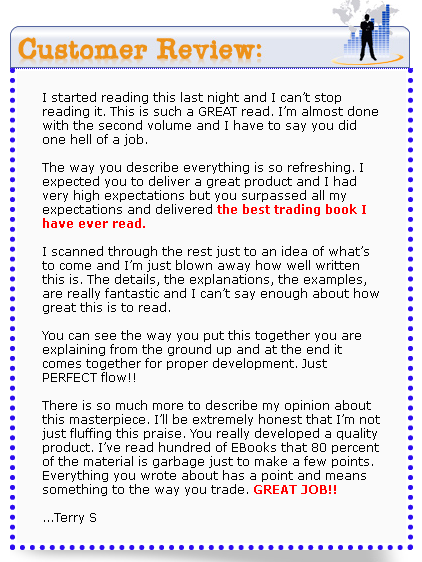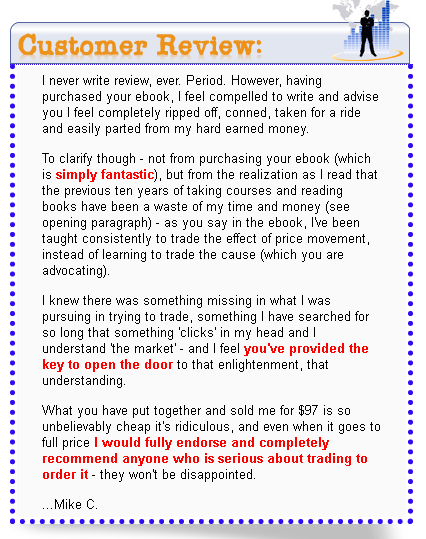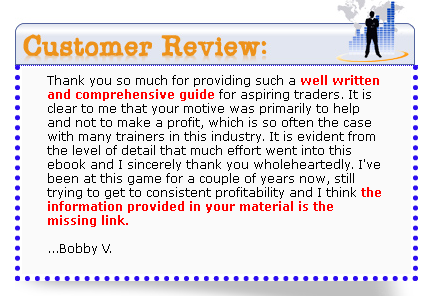Are you looking for an honest Your Trading Coach review and student testimonials?
You are on the right page!
Lance Beggs, the tutor of this course, is a professional and well-respected trader sharing his unique approach to price action trading.
He has an in-depth understanding of critical topics like:
- technical analysis of price movement in context to market structure
- the composition of high probability areas to buy and sell from
- trading psychology
- risk management
- money management strategy
- and what it truly takes to be a trader!
In this Your Trading Coach review, I will not overhype the course; I will simply allow the table of content to speak for itself (keep reading to see it).
Without further adieu, let’s dive in.
What is Your Trading Coach (Price Action Trader)?
Your Trading Coach (also called Price Action Trader) is a course (6-volume set of ebooks) designed to teach you a deeper understanding of the markets, a unique trading method, and an excellent analysis method.
It also provides you with an understanding of the process of learning, growth, and development, which all build a solid foundation for your ongoing learning process; your trader development.
After consuming the course content, you will have a strong background to be a profitable trader. It also provides you with a plan for the way forward, so all you have to do is implement what you learned.
One thing I love about the program is that it’s not promising you success, unlike many other courses being sold by fake gurus. It only teaches you how trading works and how to become a successful trader.
The course clearly states that they are no shortcuts; you need to learn how it’s being done. Forget the get-rich schemes (packaged as trading programs). It’s time to learn how to trade finally.
Your Trading Coach Review – The Price Action Trader Content Overview
In this section of Your Trading Coach review, I will quickly explore what’s inside the 6-volume ebook.
Volume One – Introduction
This is just an introduction to the trading world to keep your feet wet. It helps you set the foundation. If you need more information along the line or you are a complete beginner, section 1.4 will provide tons of links to sources of free prerequisite knowledge.
Here is the breakdown of this volume:
Chapter One – Introduction
1.1 – Introduction ………………………………………………………………………… 15
1.2 – Scope – Strategy, Markets & Time frames…………………………………. 17
1.3 – Acknowledgments…………………………………………………………………..19
1.4 – Prerequisites…………………………………………………………………………19
1.5 – Feedback…………………………………………………………………………….20
1.6 – Contents Overview…………………………………………………………………..20
Volume Two – Markets and Market Analysis
In this part, you will learn better and more effective ways of viewing the market, including the market price action. Just keep in mind that this game is not about price. Instead, it’s about O-T-. You will find the detailed explanation in chapter two.
Here is the breakdown of this volume:
Chapter Two – Principles of Markets
2.1 – Principles of Markets…………………………………………………………….. 15
2.2 – The Reality of the Markets……………………………………………………… 16
2.2.1 – Trading the Shadows…………………………………………………. 16
2.2.2 – Cause and Effect…………………………………………………….. 19
2.2.3 – What is Price?……………………………………………………….. 22
2.2.4 – How Does Price Move? …………………………………………….. 23
2.2.5 – What are Markets…………………………………………………… 32
2.2.6 – Summary – The Reality of the Markets…………………………… 37
2.3 – The Reality of the Trading Game…………………………………………. 38
2.3.1 – How Do We Profit? ………………………………………………….. 38
2.3.2 – Analysis for Profit……………………………………………………. 39
2.4 – Effective vs Ineffective Trading Strategies and Systems ………… 43
2.4.1 – Principles of my Effective Strategy……………………………….. 50
2.5 – Conclusion.…………………………………………………………………….. 52
Chapter Three – Market Analysis
In this section, you will learn the most effective tricks on analyzing prices within a multiple time frame structure.
You will also learn how to develop a bias for future price action, leveraging the signs of strength and weakness within the current price action. Plus, a comprehensive step-by-step process for your initial and ongoing analysis.
Here is the breakdown of this chapter:
3.1 – Introduction to Market Analysis……………………………………………..54
3.1.1 – The Aim of our Market Analysis……………………………………54
3.1.2 – Subjectivity vs Objectivity in Market Analysis……………………55
3.2 – Past Market Analysis…………………………………………………………..57
3.2.1 – Support and Resistance…………………………………………….57
3.2.2 – Multiple Timeframe Analysis……………………………………….72
3.2.3 – Market Structure…………………………………………………….79
3.2.4 – Trends…………………………………………………………………90
3.3 – Future Trend………………………………………………………………………113
3.3.1 – Strength and Weakness…………………………………………….113
3.3.2 – Identifying Strength and Weakness……………………………….116
3.3.3 – Principles of Future Trend Direction……………………………..145
3.3.4 – Visualising the Future………………………………………………153
3.3.5 – What Happens After S/R Holds? …………………………………….156
3.4 – Initial Market Analysis Process………………………………………………….160
3.4.1 – Initial Market Analysis Process Summary………………..……160
3.4.2 – Initial Market Analysis Checklist…………………………………..161
3.4.3 – Initial Market Analysis Example……………………………………165
3.5 – Ongoing Market Analysis – Theory …………………………… 172
3.5.1 – Determine Candle Pattern Sentiment……………………………….173
3.5.2 – Consider the Context…………………………………………………..180
3.5.3 – Does it Support our Premise? ………………………………………184
3.6 – Ongoing Market Analysis Process…………………………………………….186
3.6.1 – Ongoing Market Analysis Process Summary………………………186
3.6.2 – Ongoing Market Analysis Checklist…………………………………186
3.6.3 – Ongoing Market Analysis Example………………………………….189
3.7 – Practice……………………………………………………………………………..200
3.7.1 – Market Structure Journal…………………………………………….201
3.8 – Conclusion…………………………………………………………………………202
3.9 – Addendum to Chapter 3 – Alternative Questions for the Conduct of Price Action Analysis…………………………………………………………………203
Chapter Five – Trade Examples
In this section, you will see a detailed analysis of ten complete trades, including the wins, scratches, and losses. The truth is that you can learn from every trade.
Here is the breakdown of this chapter:
5.1 Trade Example 1 – BPB – T1 & T2 Achieved………………… 126
5.2 Trade Example 2 – PB – T1 Achieved – Part Two Worked Exit……………… 138
5.3 Trade Examples 3 – BOF, BPB, TST – Sideways Trend within another Sideways Trend……………………………………………………… 152
5.4 Trade Example 4 – CPB – T1 Achieved – T2 Trailed……….………………….. 167
5.5 Trade Example 5 – TST – Part 1 Stopped Breakeven – Part 2 Trailed……….. 177
5.6 Trade Example 6 – BOF – T1 & T2 Achieved…………………………………… 189
5.7 Trade Example 7 – TST – Part 1 Scratched, Re-entered & Stopped Out – Part 2 Stopped Out………………..………………………………. 200
5.8 Trade Example 8 – PB – Scratched – No Re-entry……………………………. 213
5.9 Trade Example 9 – CPB – T1 & T2 Achieved…………………………………… 225
5.10 Trade Example 10 – TST – Scratched & Reversed – PB – T1 Achieved – Part 2 Stopped (Trail) ..……..…………………….………………. 235
5.11 Trade Example Summary Notes…………………………………….. 250
Chapter Six – Other Markets, Other Timeframes
Lance Beggs, the tutor of this course, understands that you might not be interested in his markets and timeframe.
So in this part, he will teach you how to blend Your Trading Coach (Price Action Trader) with your markets and timeframes. This gives you room to explore several other tactics you know.
Here is the detailed breakdown of this chapter:
6.1 Other Markets, Other Timeframes………………………………… 253
6.2 Examples – Forex………………………………………………………….. 255
6.2.1 Additional Forex Considerations……………………………………… 261
6.3 Examples – Emini Futures…………………………………………………… 264
6.3.1 Additional Emini Futures Considerations……………………………. 269
6.4 Examples – Stocks & ETFs…………………………………………………. 271
6.4.1 Additional Stock & ETF Considerations…………………………….. 275
6.5 Conclusion …………………………………………………………………………… 276
Volume Four – Your Trading Business
Things start to get more serious in volume four. To start trading like a professional and treat it like a real business, you need a professional appreciation for controlling business risk, which should be documented through your money management and contingency management plans.
All this will be taught in chapter seven, eight, and nine. Here is the detailed breakdown:
Chapter Seven: Money Management
7.1 Ensuring Survival………………………………………………………. 15
7.2 Financial Survival………………………………………………………. 15
7.3 Money Management………………………………………………….. 15
Chapter Eight: Contingency Management
8.1 Contingency Management ……………………………………… 26
8.1.1 Contingency Management…………………………………………….. 26
Chapter Nine: Goals & Targets
9.1 What Win % Should You Expect? ……………………………………. 30
9.2 Ok… If I Absolutely Must!…………………………………………………… 31
9.3 Stats…………………………………………………………………………………. 31
9.4 Another Option – For the Consistently Profitable …………………. 32
In chapter 10 and 11, you will transition from learning theoretical trading psychology to a practical approach. You will also learn about the tools and techniques Lance found most crucial to maintain improved focus on process and a positive, high-performance mindset, even when there are negative distractions.
Chapter Ten: Trading Psychology – A Practical Approach
10.1 Personal Survival………………………………………….. 37
10.2 Prerequisites for Survival……………………………………. 37
10.3 Mastery of Trading Psychology …………………………………. 42
10.3.1 Focus on Process ………………………………………………. 42
10.3.2 Peak Performance Mindset …………………………………………. 45
10.4 Maintenance of Peak Physical Condition …………………. 53
10.5 Psych Wrap-Up …………………………………………………………. 58
10.6 Additional Study ………………………………………………………… 58
Chapter Eleven: Trading Platform Setup
11.1 Trading Platform Setup ……………………………………………… 60
In chapter 12 and 13, you will have access to a complete Trading Plan template, plus an in-depth sample Procedures Manual, which will be helpful for outlining your daily pre-session, during the session, and post-session routines.
Here is the breakdown:
Chapter Twelve: Trading Plan
12.1 Trading Plan ……………………………………………………………….. 65
12.2 Trading Plan Template ……………………………………………………. 67
12.3 Trading Plan – Explanatory Notes …………………………………. 69
12.3.1 Cover Page …………………………………………………………….. 69
12.3.2 Preface …………………………………………………………………. 69
12.3.3 Introduction ……………………………………………………………. 70
12.3.4 The Trader …………………………………………………………….. 70
12.3.5 The Trading Business ……………………………………………….. 71
12.3.6 The Trading Process …………………………………………………. 74
12.3.7 Annexes ……………………………………………………………….. 76
Chapter Thirteen: Procedures Manual
13.1 Procedures Manual ……………………………………………………….. 78
13.2 Sample Procedures Manual ……………………………………………… 78
In chapter 14, you will discover the additional documentation that keeps your head above the water and sets you apart from inexperienced traders. You will learn how to start trading like a Pro, including all essential components of your record and review processes.
Here is the breakdown:
Chapter Fourteen: Additional Documentation
14.1 Additional Documentation ……………………………………………… 106
14.2 Trading Journal Spreadsheet ………………………………………….. 106
14.3 Trading Log………………………………………………………………………… 106
14.4 Motivation Journal …………………………………………………………. 108
14.5 Lessons Learnt Journal …………………………………………………… 108
14.6 Market Structure Journal ………………………………………………. 109
14.7 Trades Journal……………………………………………………………….. 110
Volume Five – Trader Development
Chapter 15 and 16 will make you understand why learning to trade is a process of personal growth and development.
You will be educated on the best tools and techniques you need to enjoy an effective learning process and see quick and efficient progress in your trader and development journey.
Here is the breakdown:
Chapter Fifteen: The Journey
15.1 FACT: Most Readers Will Fail to Achieve Consistent Profitability ………… 15
15.2 The Journey………………………………………………………………………… 17
Chapter Sixteen: The Learning Process
16.1 Effective Learning ………………………………………………………….. 20
16.2 Deliberate Practice …………………………………………………….. 20
16.3 Trade-Record-Review-Improve …………………………………. 21
16.4 Deliberate Practice Tools and Techniques ………………….. 22
16.4.1 Defined Trading Procedures …………………………………………. 22
16.4.2 Trading Logs and Journals ……………………………………… 22
16.4.3 Documented Review Process ……………………………… 22
16.4.4 Market Replay …………………………………………………… 23
16.4.5 Market Replay Alternatives………………………………………….. 26
16.4.6 Peer Review……………………………………………………………. 26
In chapter 17, you will be given a complete plan for taking action, which advances stage by stage across the four stages of trader development.
Here is the breakdown:
Chapter Seventeen: Taking Action
17.1 Taking Action ………………………………………………………………. 29
17.2 The Development Stages ………………………………………………… 29
17.2.1 Stage 1 – Establish Your Foundation ………………………… 30
17.2.2 Stage 2 – Simulator Environment ……………………………… 33
17.2.3 Stage 3 – Live Environment – Minimum Size ………………… 34
17.2.4 Stage 4 – Live Environment – Increasing Size ……………. 35
17.2.5 As You Progres ……………………………………………………… 35
17.3 Taking Action – Alternate Strategies ………………………………… 36
17.4 Challenges and Difficulties ……………………………………………….. 37
17.5 The Target………………………………………………………………………….. 41
17.6 Additional Study …………………………………………………………… 41
Volume Six – Conclusion
This wraps up the whole course with a useful summary chapter, including diagram summaries, text summaries, and setups poster.
Here is the breakdown:
Chapter Eighteen: Conclusion
18.1 Summary …………………………………………………………………… 15
18.1.1 Principles of Markets – Summary ……………………………… 15
18.1.2 Market Analysis – Summary…………………………………………. 17
18.1.3 Trading Strategy – Summary…………………………………………. 20
18.1.4 Setups Poster…………………………………………………………. 29
18.1.5 The Learning Process – Summary………………………………….. 30
18.2 For Those Concerned That It Appears Too Simple ……………. 31
18.3 And For Those Who Perceive It As Too Complex …………….. 32
18.4 Take Action …………………………………………………………………… 32
18.5 Wrap Up …………………………………………………………………………. 33
18.6 Supplementary Resources ……………………………………………. 33
If you go through the course to this stage, congratulations, you are set to flourish and thrive in the world of trading. It’s time to take action…Go for it!
For the next section of this Your Trading Coach Review (Price Action Trader), we will see some of the testimonials from real students who have taken the course.
Your Trading Coach Price Action Trader Testimonials From Real Students
In this part of this Your Trading Coach review, you will see what students say about this course.





Your Trading Coach (Price Action Trader) Pros & Cons
Pros:
- The course is compiled by a well respected, professional trader (Lance Beggs)
- It leaves no stone unturned (you will learn the crucial things you need to know)
- Lots of positive reviews from students
- Teaches you how to trade, rather than promising you questionable success
- It’s affordable compared to other trading programs
- 60 days money-back guarantee
Cons:
- Some consider the course to be too long (590 pages)
Your Trading Coach Review: How Much is the Price Action Trader?
There are two pricing plans for this course.
You can get Your Trading Coach (Price Action Trader) course for a one-time payment of $197. This will grant you access to:
- Instant PDF download
- Six Volumes
- 590 pages of quality trading education
- Including 377 charts and diagrams
- PLUS NOW WITH 2 BONUSES – FAQ Document (2 volumes) + 42 minute mp4 video (Future Trend – Simplified)
Or, you can buy Your Trading Coach (Price Action Trader) program for a one-time payment of $294, which allows you to enjoy everything you get with YTC Price Action Trader PLUS the supplementary YTC Scalper ebook.
YTC Scalper teaches you how to apply Your Trading Coach on lower timeframes.
The best part is that there is a 60-day money-back guarantee on the plans. If you think the course is not worth the price, you can request a 100% refund within 60 days of your purchase.
Cool, right!
Conclusion
In this Your Trading Coach review, you have seen what’s inside Lance Beggs Price Action Trader course. The 6-volume ebook is one of the greatest resources for learning how to become a professional trader at an affordable price.
What’s even more interesting is that Lance allows you to ask for a refund within 60 days of purchase if you are not satisfied with the content. You have nothing to worry about.
So after reading this Your Trading Coach review and testimonials from students, are you ready to become a professional trader? Click the link below to buy the course.
Related:

Leave a Reply